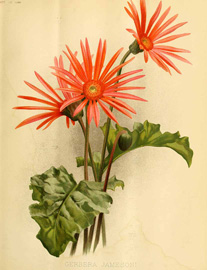Generous Gerbera
by Audrey Stallsmith

Gerbera jamesonii is very fine this year, throwing up flowers since May and likely to continue so until frost sets in. Every visitor admires the vivid scarlet of the aster-like flowers.
“Notes from Baden-Baden,” The Garden, September 1897
Whenever I visit our local Wal-Mart during the summer, I always make a beeline to a back corner where the reduced plants are stashed. They have been discounted for a reason, of course, either because they have stopped blooming or started shriveling. However, that means their price usually has been cut in half, which makes them attractive to low-income writers like me.
Also, saving lives—even if they only are plant lives—always makes me feel virtuous about my purchases! One of my recent rescues was a large and leafy gerbera with only a couple stunted flowers on it.
Gerberas are a relatively recent addition to the gardening world, being discovered around 1878 by a Scotsman named Robert Jameson, who owned a condiments company in Durban, South Africa. When he heard of a gold strike near Barberton, he started a mining company too. Whether he discovered any gold, I can’t say, but he did bring some flowers he’d found at the “diggings” back to Durban. Those eventually would be dubbed Gerbera jamesonii in his honor.
The genus derives from a German doctor named Traugott Gerber. He probably had nothing to do with the flower but was a friend of Carl Linnaeus, who provided scientific names to so many plants. Since Linnaeus lived in the 1700s, we can conclude that other gerberas must have turned up before jamesonii did. These days, however, they often are called Barberton daisies or Transvaal daisies for the town and province where the jamesonii type originated.
Those “daisies” didn’t make it big in America until about the 1920s, but have since become highly popular as cut flowers. Being so large and brightly colored, they are a thoughtful gift for elderly persons with poor eyesight who might not be able to appreciate less gaudy blooms.
I have grown Gerbera jamesonii from seed, and can report that its flowers are smaller and more narrow of petal than the modern hybrids—which were derived from crosses between jamesonii and viridifolia. Keep in mind that gerbera seeds lose viability quickly, so only purchase them from a company which specifies that they have been kept in cold storage.
I’ve found that E-bay sellers often try to pass off chaff as gerbera seeds, and I’ve also received nonviable seeds in seed swaps. So it’s a good idea to ask questions before either buying or swapping for the seeds.
The plants should be hardy for you gardeners who live in USDA zones 8 through 11. There, they can bloom off and on all year, but most heavily in early summer and late autumn. Just remember to position them so that their root crowns are a bit higher than the surrounding soil, since they rot easily. The rest of us will have to bring gerberas indoors during the winter if we wish to keep them.
That could be a good thing, since they reportedly help cleanse the air of such chemicals as benzene and trichloroethylene. And who knows? Their bright blooms may also cleanse your mind of depressing thoughts.
Gerbera jamesonii image is from an 1889 edition of The Garden, courtesy of plantillustrations.org.








